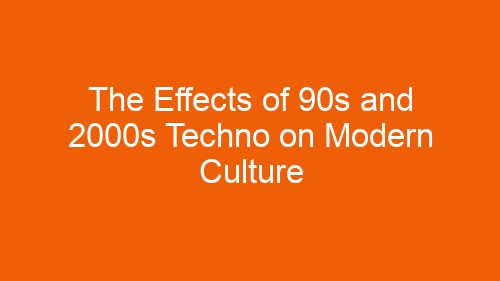-
Table of Contents
Evolution of Dance Music Trends
The 1990s and 2000s were a pivotal time for the evolution of dance music, particularly in the realm of techno. The emergence of techno in these decades had a profound impact on modern culture, influencing not only the music industry but also fashion, art, and even social movements. The sounds and styles that originated during this time continue to shape the way we experience and interact with music today.
One of the key effects of 90s and 2000s techno on modern culture is the way it revolutionized the electronic music scene. Techno music, with its repetitive beats and futuristic soundscapes, provided a new and exciting alternative to traditional genres. Artists like The Chemical Brothers, Daft Punk, and Aphex Twin pushed the boundaries of what was possible with electronic music, paving the way for a new generation of producers and DJs to experiment and innovate.
The influence of 90s and 2000s techno can also be seen in the fashion world. The bold, futuristic aesthetic of techno music inspired a new wave of fashion designers to incorporate elements of rave culture into their collections. Bright colors, metallic fabrics, and oversized silhouettes became synonymous with the techno scene, influencing everything from streetwear to high fashion.
In addition to its impact on music and fashion, 90s and 2000s techno also played a significant role in shaping the art world. The visual aesthetic of techno music, with its emphasis on technology and futurism, inspired a new wave of artists to explore themes of digital culture and virtual reality in their work. Installations, performances, and exhibitions that drew inspiration from techno music became increasingly popular, blurring the lines between art and music in exciting new ways.
Furthermore, the influence of 90s and 2000s techno on modern culture can be seen in the way it has shaped social movements and political activism. The inclusive and diverse nature of the techno scene, with its emphasis on unity and acceptance, has inspired a new generation of activists to use music as a tool for social change. Techno parties and festivals have become spaces where people from all walks of life can come together to celebrate their differences and work towards a more inclusive society.
Overall, the effects of 90s and 2000s techno on modern culture are far-reaching and profound. From music and fashion to art and activism, the influence of techno from these decades continues to shape the way we experience and engage with the world around us. As we look to the future, it is clear that the legacy of 90s and 2000s techno will continue to inspire and influence generations to come.
Influence on Fashion and Style
Techno music has had a profound impact on modern culture, influencing not only the music industry but also fashion and style. The 90s and 2000s were particularly significant decades for techno music, with artists like Daft Punk, The Chemical Brothers, and Fatboy Slim dominating the airwaves and shaping the sound of the era. This music not only defined a generation but also influenced the way people dressed and presented themselves.
One of the most noticeable effects of 90s and 2000s techno on modern culture is its influence on fashion. The music of this era was characterized by its futuristic and electronic sound, which translated into a bold and edgy fashion aesthetic. Bright colors, metallic fabrics, and avant-garde silhouettes became popular among fans of techno music, who sought to emulate the style of their favorite artists.
The rise of techno music in the 90s and 2000s also coincided with the emergence of rave culture, which further shaped the fashion trends of the time. Ravers were known for their eclectic and flamboyant style, often incorporating elements of cyberpunk, goth, and streetwear into their outfits. This subculture embraced bold patterns, oversized clothing, and unconventional accessories, creating a unique and rebellious look that continues to influence fashion today.
The influence of 90s and 2000s techno on modern fashion can be seen in the popularity of athleisure wear, which combines comfort and functionality with a futuristic aesthetic. Brands like Adidas, Nike, and Puma have capitalized on this trend, creating collections that draw inspiration from the bold colors and graphic prints of techno music. Celebrities and influencers have also embraced this style, wearing tracksuits, sneakers, and hoodies as everyday attire.
In addition to athleisure wear, the influence of 90s and 2000s techno can be seen in the resurgence of 90s fashion trends like crop tops, platform shoes, and bucket hats. These nostalgic styles have made a comeback in recent years, with designers and retailers capitalizing on the popularity of retro fashion. The music of this era continues to inspire new generations of fashion designers, who reinterpret its themes and motifs in their collections.
The impact of 90s and 2000s techno on modern culture extends beyond fashion, influencing the way people express themselves through style. The music of this era encouraged self-expression and individuality, inspiring fans to experiment with their look and push the boundaries of conventional fashion. This spirit of creativity and innovation continues to shape the way people dress and present themselves, with many embracing a more eclectic and personalized approach to style.
In conclusion, the effects of 90s and 2000s techno on modern culture are undeniable, particularly in the realm of fashion and style. The bold and futuristic aesthetic of this music has influenced the way people dress and present themselves, inspiring new trends and pushing the boundaries of conventional fashion. As we continue to look back on this era with nostalgia and admiration, it is clear that the influence of techno music will continue to shape the way we express ourselves through style for years to come.
Impact on Technology and Digital Media
The 90s and 2000s were a transformative time for techno music, with the rise of electronic dance music (EDM) and the proliferation of digital media. The impact of techno music from this era can still be felt in modern culture, particularly in the realm of technology and digital media.
One of the most significant effects of 90s and 2000s techno on modern culture is its influence on technology. The use of synthesizers, drum machines, and other electronic instruments in techno music paved the way for advancements in music production technology. Artists from this era pushed the boundaries of what was possible with electronic music, inspiring the development of new tools and software for creating and manipulating sound.
This influence can be seen in the rise of digital audio workstations (DAWs) like Ableton Live and Logic Pro, which have become essential tools for modern music producers. These software programs allow artists to create complex, layered tracks with ease, replicating the intricate soundscapes that were a hallmark of 90s and 2000s techno music.
Techno music from this era also played a significant role in shaping the digital media landscape. The rise of the internet and the proliferation of digital music platforms like SoundCloud and Spotify have made it easier than ever for artists to share their music with a global audience. The DIY ethos of techno music from the 90s and 2000s has carried over into the digital age, with many artists using social media and streaming platforms to connect directly with fans and build a following.
The influence of 90s and 2000s techno on modern culture can also be seen in the way that music is consumed and experienced. The rise of streaming services has made it easier for listeners to discover new music and explore different genres, including techno. The accessibility of digital music has helped to broaden the audience for techno music, bringing it out of the underground and into the mainstream.
Techno music from the 90s and 2000s has also had a lasting impact on the way that music is performed and experienced live. The rise of electronic music festivals like Tomorrowland and Ultra Music Festival has brought techno music to a global audience, with artists from the 90s and 2000s still headlining these events. The use of cutting-edge technology like LED screens, lasers, and pyrotechnics has transformed the live music experience, creating immersive environments that enhance the music and engage the audience.
In conclusion, the effects of 90s and 2000s techno on modern culture are far-reaching, particularly in the realm of technology and digital media. The influence of techno music from this era can be seen in the advancements in music production technology, the rise of digital music platforms, and the transformation of the live music experience. As we continue to embrace the digital age, the legacy of 90s and 2000s techno will continue to shape the way we create, consume, and experience music.




















